Long-Term Residency (Larga Duración) in Spain: Complete Guide and How to Apply
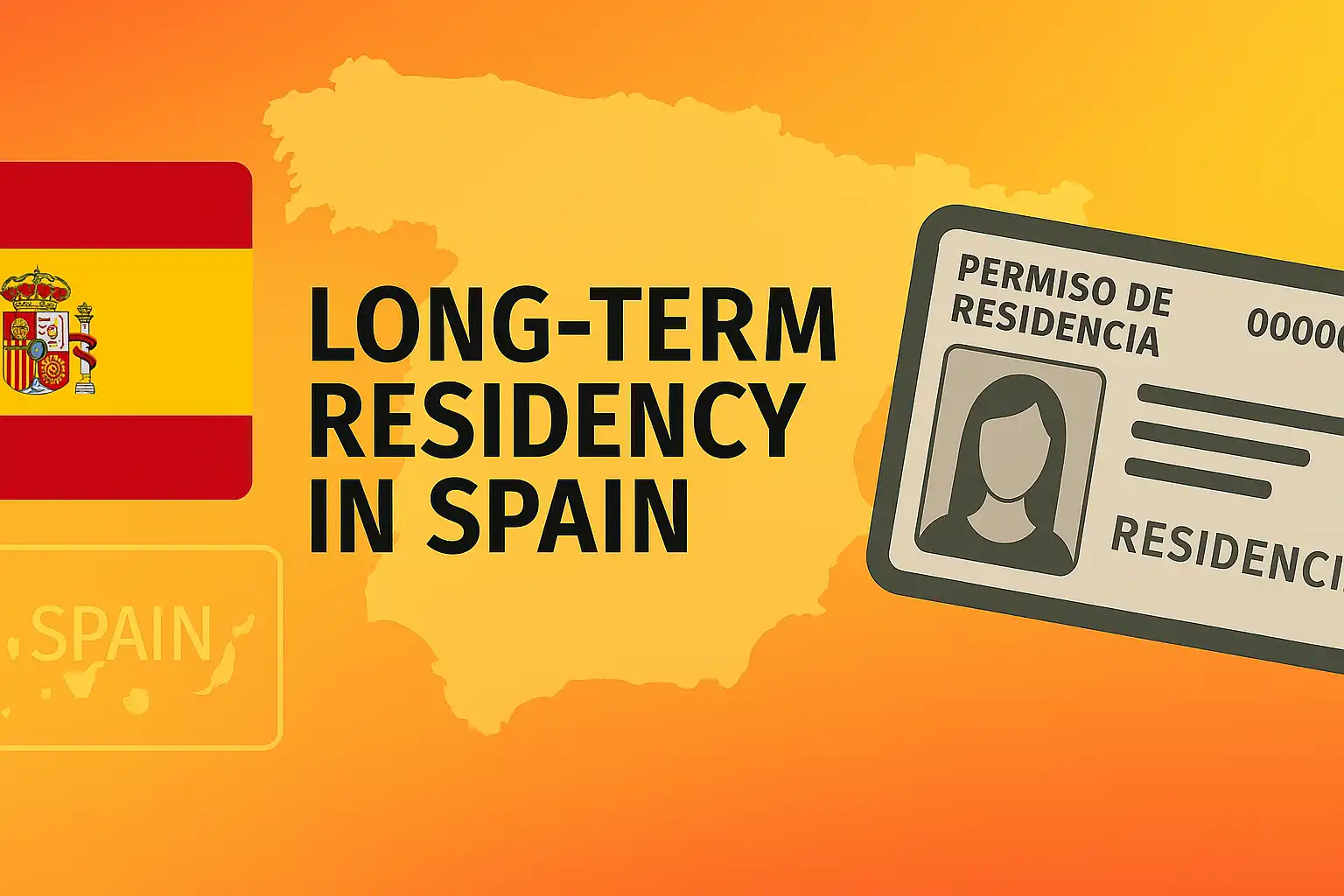
The Residencia de Larga Duración is currently the only Long-Term Residency Permit option in Spain. This permit allows non-EU nationals to stay and work in Spain under similar conditions to Spanish nationals. There are two key types of long-term residency available: one valid only in Spain (LD España), and another with benefits across the EU (RLD-UE).
Key Takeaways
- Spain offers two long-term residency types: LD (valid in Spain) and LD-UE (includes EU mobility).
- You can apply after 5 years of legal stay - or sooner if you qualify under special cases like pension, disability, or Blue Card.
- LD-UE requires health insurance and stable income, and lets you move more easily across EU countries.
- Make sure not to spend over 12 months outside the EU (or 6 years outside Spain if you hold LD-UE), to avoid losing your residency status.
- Family members of LD-UE holders are eligible for LD-Spain residency without needing 5 years of residence.
Get your personalized relocation checklist, step-by-step guidance, and access to our complete immigration app.
What are the different pathways to qualify for Long-Term Residency in Spain?
There are several legal pathways that allow foreign nationals to qualify for long-term residency (Larga Duración or LD) or EU long-term residency (Larga Duración-UE) in Spain. These include:
- Continuous legal residence in Spain for 5 years.
- Previous residency in other EU countries under the Blue Card or LD-UE.
- Special conditions such as retirement, disability, birth in Spain, or stateless status.
- Family members of EU long-term residents or individuals recovering their former long-term resident status.
Each pathway has its own legal requirements and required documentation. See below for detailed sections for each specific type.
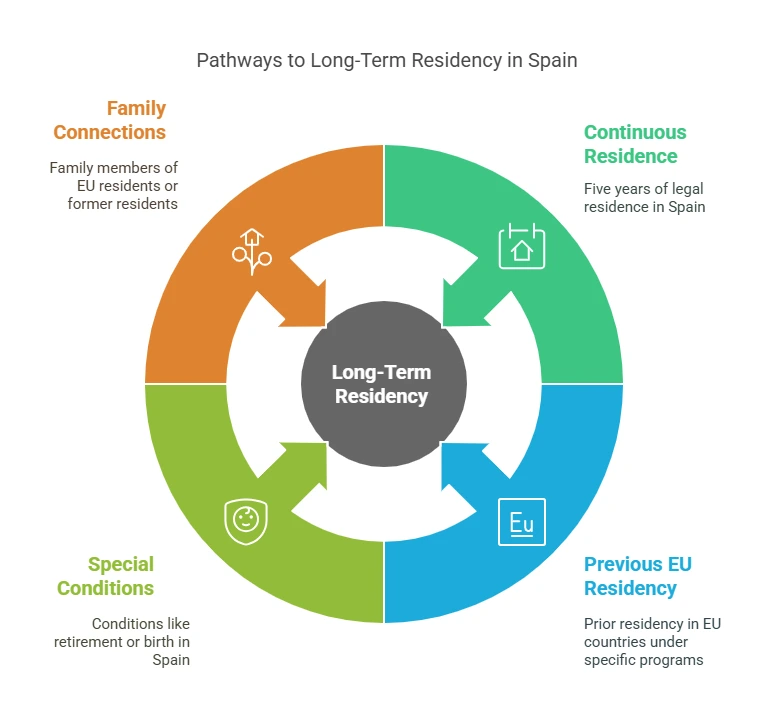
Requirements for the General Long-Term Residency in Spain
To be eligible for Larga Duración in Spain, the applicant must:
- Not be a citizen of the EU, EEA, or Switzerland.
- Have no criminal record in Spain or any previous countries of residence.
- Not be banned from entering Spain or appear as rejectable in countries with shared entry agreements.
- Meet one of the following conditions:
- Have legally and continuously resided in Spain for 5 years. Short absences are allowed: up to 6 months at a time, not exceeding 10 months total (or 12 for work) over 5 years.
- Have held a EU Blue Card for 5 continuous years in the EU, with the last 2 years in Spain. Absences from the EU must not exceed 12 consecutive months or 18 total months in 5 years.
- Be a recipient of a Spanish contributory pension for retirement.
- Be a recipient of a contributory permanent disability or severe disability pension under the Spanish system.
- Have been born in Spain and lived there legally and continuously for the 3 years prior to application, after turning 18.
- Be a former Spanish national who has lost Spanish citizenship.
- Have been under the custody of a Spanish public entity during the 5 years prior to turning 18.
- Be a recognized stateless person, refugee, or under subsidiary protection in Spain.
- Have made significant contributions to Spain’s economic, scientific, cultural, or international profile, supported by the Ministry of Employment.
Required Documentation:
- Form EX-11↗, completed and signed.
- Copy of entire passport.
- Certificate of school enrollment for minors (if applicable).
- Criminal record certificate from countries of residence for the past 5 years.
- Proof of Payment of Tasa 790 052↗
- Specific supporting documents for each case (birth certificate, pension certificate, Blue Card proof, etc.).
- All foreign documents must be translated into Spanish and legalized or apostilled as per international agreements.
Requirements for the EU Long-Term Residency Permit in Spain
To be eligible for Larga Duración-UE, the applicant must:
- Not be an EU/EEA/Swiss citizen or their family member under EU regime.
- Have no criminal record in Spain or former countries of residence.
- Not be banned from entry in Spain or similar territory.
- Have legally and continuously resided in Spain for 5 years.
- Absences up to 6 months allowed (max. 10 months total in 5 years, or 12 months if for work).
- Time spent on a student visa or exchange counts at 50% if followed by a residence permit.
- Hold a EU Blue Card with at least 2 years of residence in Spain, and prior residence in the EU Blue Card system totaling 5 years.
- Show proof of stable and regular income to support themselves and family:
- 150% of IPREM for 2 people, +50% for each additional person.
- Income can come from employment, self-employment, or passive sources.
- Show proof of health insurance, either public or private.
Required Documentation:
- Form EX-11↗.
- Complete passport copy.
- Financial documentation (Employment Letter, Tax Returns, Bank Statements, Invoices, etc ).
- Proof of payment of Tasa 790 052↗
- Health insurance certificate (public and/or private).
- Proof of prior EU Blue Card residence (if applicable).
- Translated and legalized documents as required.
Requirements for recovering a previously held Long-Term Residency in Spain
This applies to foreign nationals who previously held a Spanish long-term residence permit and lost it due to extended absence or voluntary renunciation.
Eligibility conditions:
- You must not have been expelled from Spain.
- You must submit your application at a Spanish consulate or upon return to Spain, and justify your right to regain long-term resident status.
Documents Required:
- Form EX-11↗.
- Proof of previous long-term residency in Spain.
- Passport copy.
- Proof of payment of Tasa 790 052↗
- Criminal record certificate from all countries of residence for the past 5 years.
- Any supporting documents explaining the reason for the loss and return intent.
Requirements for recovering EU Long-Term Residency in Spain
This applies to those who previously held a Larga Duración-UE permit in Spain and lost it, often due to prolonged absence from EU territory.
Key requirements:
- You must justify your previous status and the reason for recovery.
- Submit the application either from abroad via consulate or directly in Spain.
Required Documents:
- Form EX-11↗.
- Passport copy.
- Documentation proving previous EU long-term resident status in Spain.
- Proof of payment of Tasa 790 052↗
- Supporting documents (criminal record, justification of return).
Requirements for holders of Long-Term EU Residency from another EU country
This applies to individuals who hold a Larga Duración-UE permit from another EU member state and wish to establish residence in Spain.
Conditions:
- You must present valid documentation of your long-term EU residency.
- Demonstrate your intention to reside in Spain.
Required Documents:
- EX-11 form↗.
- Copy of valid Larga Duración-UE permit from the other EU country.
- Passport.
- Proof of payment of Tasa 790 052↗
- Justification of your move to Spain (employment, family reasons, etc.).
Requirements for family members of Long-Term EU Residents in another EU country
This option is for family members of foreigners holding a Larga Duración-UE permit in another EU country who wish to join them in Spain.
Requirements:
- Proof of the family relationship.
- Copy of the sponsor’s valid LD-UE permit in another EU state.
- Proof of adequate housing, financial means, and health insurance.
Required Documents:
- EX-11 form↗.
- Passport copy.
- Proof of payment of Tasa 790 052↗
- Copy of sponsor’s LD-UE card.
- Marriage or birth certificates.
- Financial and housing proof (Empadronamiento).
- Translations and legalizations as needed.
Requirements for Permanent Residency as a Family Member of an EU Citizen
This applies to non-EU family members of EU citizens who already hold 5 years of continuous residence under the EU regime.
Requirements:
- Continuous legal residence in Spain as a family member for at least 5 years.
- Proof of continued family relationship (marriage, partnership, parenthood).
Required Documents:
- Application form for permanent EU family card.
- Passport copy.
- Valid residence card.
- Certificate of registration of the EU citizen family member.
- Marriage or birth certificate.
- Documents must be translated and legalized if needed.
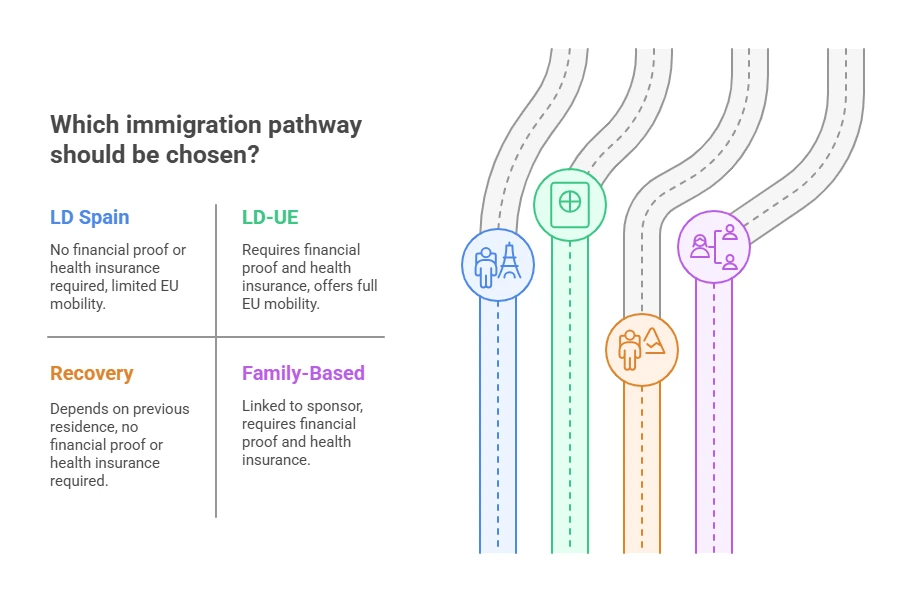
How to Apply for Long-Term Residency (Larga Duración)?
1. Gather documents:
- EX-11 application form↗
- A copy of all pages of your Passport
- Current residency card (TIE)
- Proof of 5 years of legal residence (empadronamiento history, social security contributions, residency cards)
- Criminal record certificate
- Passport-sized photo
- Payment proof of Tasa 790 052↗
For LD-UE applications:
- Financial documentation and health insurance certificate
💶 What financial proof do I need?
- If employed: Job contract and last 3 payslips
- If self-employed (autónomo): Tax returns (Modelo 130 or Modelo 131)
- If not working:
- Bank certificate showing balance
- Last 6 months' bank statements
- Explanation of income sources (savings, property sale, pension, etc.)
For health insurance: Provide a certificate from a public or private insurance provider authorized in Spain.
How to Pay the Application Fee
- Fill and submit Modelo 790 052↗
- Tick box 2.6: "Autorización de residencia de larga duración y autorización de residencia de larga duración-UE"
- Pay €21.87
Where and How to Submit Your Application
Online (Recommended):
- Apply through MERCURIO platform: MERCURIO↗
- Or via Registro Electrónico: Registro Electrónico↗
- Address to: Oficina de Extranjería Madrid – Code: EA0040721
In-Person:
- Submit at a registry of:
- Spanish Central Government
- Regional Government (Comunidad Autónoma)
- Your local Town Hall (Ayuntamiento)
By Post (via Correos):
- Use ORVE Service (recommended)
- Or send via administrative mail to:
- Oficina de Extranjería
- Calle García de Paredes, 65
- 28010 Madrid
What are the most common mistakes when applying for long-term residency?
Applicants often make avoidable errors that lead to delays or rejections. Here are the most frequent ones to watch out for:
- ❌ Submitting incomplete or untranslated documents, especially certificates from outside Spain
- ❌ Applying too early, before completing the 5-year legal residency period
- ❌ Using the wrong tax form or incorrect Tasa code (always double-check the correct box on Modelo 790 052)
- ❌ Forgetting to track time spent outside Spain or the EU (too many days abroad can disqualify you)
- ❌ Not renewing your TIE card on time, even if your residency is indefinite, your TIE must be kept valid.
How do I Get the Spanish Criminal Record Certificate (Certificado de Antecedentes Penales)?
You can get it by visiting this link Ministerio de Justicia↗ and selecting "Solicitud de certificado electrónico de Antecedentes Penales para personas físicas"
How Long Does It Take to Get a Decision?
Average processing time: 1 to 3 months (may vary by province).
Administrative silence (silencio administrativo):
| Application Type | Administrative Silence | Meaning |
|---|---|---|
| Larga Duración (LD) | ✅ Yes, after 3–4 months | Considered approved by default if no reply after 3–4 months |
| Larga Duración-UE (LD-UE) | ❌ No | Must wait for official approval |
How to Get the TIE Card After Approval
- Get an appointment at the Extranjeria↗ or your local Police Station↗.
- Fill EX-17 form↗
- Bring a recent passport photo (different from previous TIE)
- Provide a copy of resolution approving your residency application
- Pay Tasa 790 Código 012: Fill it here↗ and select the option "TIE que documenta la autorización de residencia de larga duración o de residencia de larga duración-UE." for LD or LD-UE TIE card
How do I fill the Form EX-17 to apply for the Residence Permit Card (TIE)?
To Fill Form EX-17↗, follow these steps:
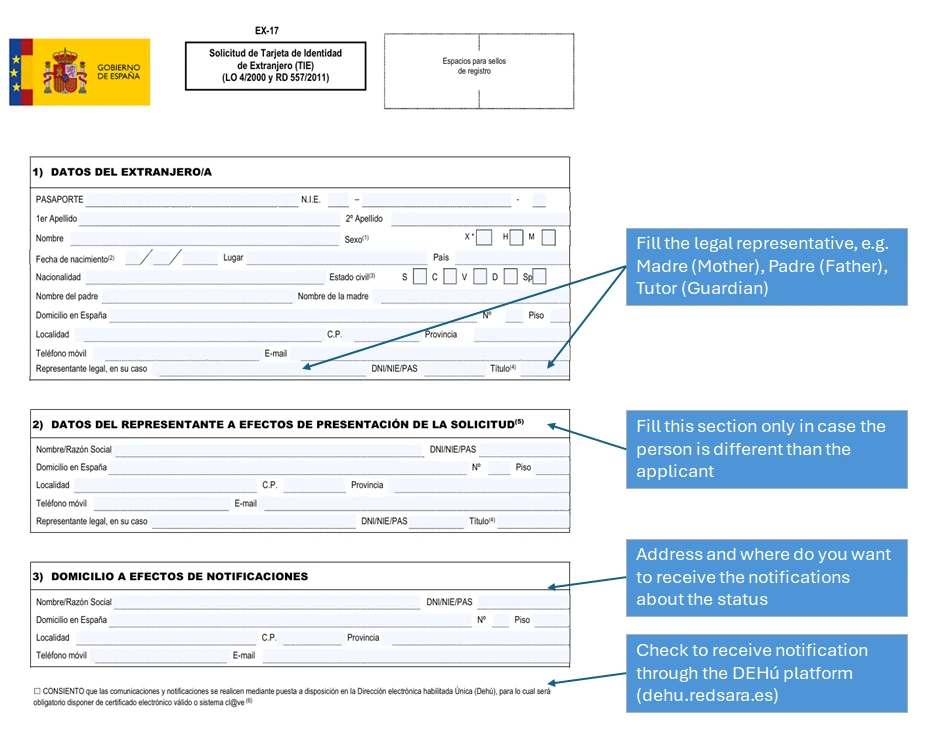

How to I pay for Tax 790 012?
You can pay for Tax 790 012 by filling the tax form and payingonline or at your nearest bank, follow these steps:
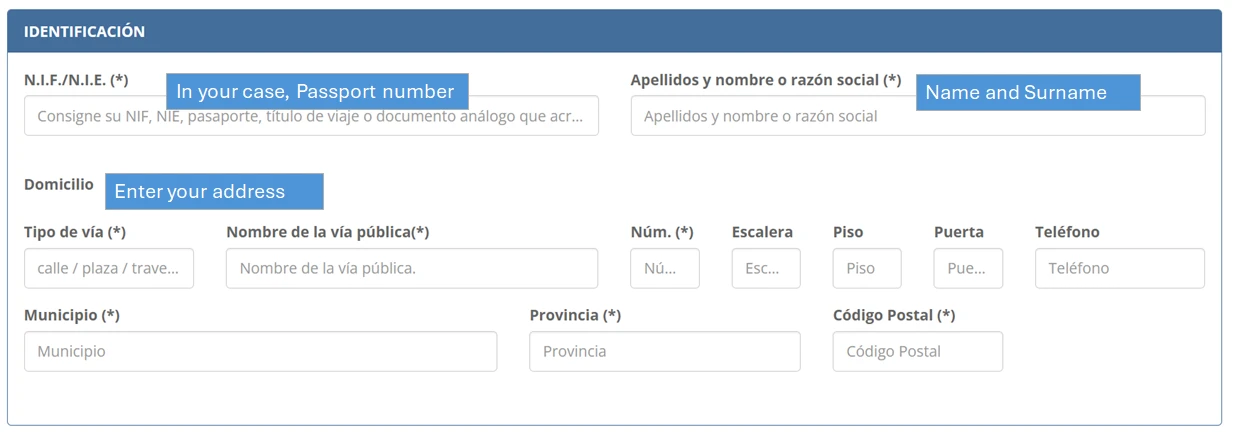



How to Check if Your TIE Card is Ready for Collection
It usually takes about 30-40 days for your TIE (Tarjeta de Identidad de Extranjero) card to be ready, but here's how you can check precisely if your card is available:
-
Locate Your Lot Number:
- Find the receipt you received when submitting your TIE application. Your lot number (número de lote) is indicated here.
-
Visit the Official Website:
- Go to the Cita previa de Extranjería website↗.
-
Select Your Province and Office:
- Choose your province from the list provided.
- Under "Selecciona Oficina", choose the specific office where you submitted your TIE application.
-
Select the Relevant Procedure:
- In "Selecciona trámite", choose "RECOGIDA DE TARJETA DE IDENTIDAD DE EXTRANJERO (TIE)", then click "ACCEPTAR".
-
Check the Latest Lot Number:
- The next page will display the message "EL ÚLTIMO LOTE RECIBIDO EN LA OFICINA SELECCIONADA ES EL [NUMERO]".
If your lot number is less than or equal to the displayed lot number, your TIE card is ready for collection. If your lot number is higher, you must wait and check again later.
Once confirmed, proceed to book your appointment for collection.

What Are the Benefits of Long-Term Residency in Spain?
- Long Term residence in Spain
- Right to work (as employee or self-employed)
- Access to public healthcare and education
- Family reunification rights
- No need for annual renewals
- Ability to recover your status if lost due to absence
How to Maintain Your Long-Term Residency Status
- Do not leave the EU for over 12 consecutive months (LD)
- For LD-UE: Do not leave Spain for over 6 consecutive years
- Renew your TIE card every 5 years (status remains valid indefinitely)
Can I Lose My Long-Term Residency in Spain?
Yes, you may lose your LD or LD-UE status if:
- You leave the EU for more than 12 consecutive months
- You obtain LD status in another EU country
- You are absent from Spain for over 6 years (LD-UE only)
- You commit a serious offense or submit false documents
How Can I Recover My Lost Long-Term Residency?
- Submit EX-11↗ form
- Include: Passport, criminal record certificate, medical certificate (if abroad), and proof of past residency
- Pay Tasa 790 052↗ again
- Apply at a Spanish Consulate (if abroad) or at a Spanish immigration office upon re-entry
- After approval, apply for a new TIE card
What’s the Difference Between LD and LD-UE?
| Feature | Larga Duración (LD) | Larga Duración-UE (LD-UE) |
|---|---|---|
| Validity | Indefinite (Spain) | Indefinite (Spain + EU mobility) |
| Work Rights | ✅ Yes | ✅ Yes |
| EU Mobility | ❌ No | ✅ Yes (requires approval in new EU country) |
| Additional Requirements | None beyond 5 years | Yes – financial proof + insurance |
| Loss due to Absence | >12 months from EU | >6 years from Spain or >12 months from EU |
Get your personalized relocation checklist, step-by-step guidance, and access to our complete immigration app.
Frequently Asked Questions

Gerard B.
An expat who's done it, so you don't have to!
After spending years in Spain and thousands of euros on lawyers, tax advisors, and residency applications, only to realize that doing it yourself is often easier, cheaper, and just as effective. Gerard is an expat on a mission to help others avoid the same costly mistakes. By creating LiveLoveSpain, Gerard aims to share first-hand experiences, practical tips, and plenty of "Why didn't anyone tell me this?!" moments. Whether it's filing taxes, understanding visas, or just mastering the art of the sobremesa, he's here to help fellow expats integrate seamlessly without breaking the bank.